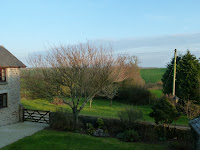 Sunshine and showers...glorious weather one moment, pouring with rain and miserable the next. On days like these, waterproofs are dragged on just in time to see the end of the shower, and then packed away again as the next grey cloud rears it's ugly head.
Sunshine and showers...glorious weather one moment, pouring with rain and miserable the next. On days like these, waterproofs are dragged on just in time to see the end of the shower, and then packed away again as the next grey cloud rears it's ugly head.On Friday, amidst the frustrating weather, I completed the first of my survey squares for Plantlife's Wildflowers Count 2012 (http://www.plantlife.org.uk). My survey route ran along the coast path in south Cornwall, near Pentewan; a stunning location.


About halfway along the survey, this Speckled Wood Butterfly (Pararge aegeria) was basking in the sun, and for once, I was fully prepared to capture it. These photos show just how papery thin the butterfly's wings are!
Although primarily found in woodland, they can also be seen anywhere that has sufficient scrub cover. There are three subspecies of this butterfly which are found across the UK; the colours of which change corresponding to location. This species is doing well throughout it's range, and is believed to be increasing. Nectar sources are also readily available with favoured species including bramble, ragwort, cuckooflower and dandelion.
 I also was privy to a territorial battle between two male stonechats...each preaching from a separate fencing post.
I also was privy to a territorial battle between two male stonechats...each preaching from a separate fencing post.Male Stonechats (Saxicola torquata) (pictured, right) have dark black heads, orangey-red breasts and a white collar. Their name is derived from their call which sounds like to stones being clicked together. They breed mainly in the south and west of Britain, and are more visible in coastal locations. This was my first stonechat sighting, and was an incredibly easy bird to identify. Atleast two females were nearby, and visually resemble the males although, as with many other birds, are toned down and duller in appearance.
 Other sightings included a Swift (Apus apus) on the wing, identifiable by the deeply forking tail. There were several House Martins (Delichon urbica) flying at head height between the beach and harbour in Pentewan; the fleeting sunshine highlighted the glossy blue-black of their plummage. There were Pied Wagtails (Motacilla alba) (pictured, left) in a car-park area, and I stood and watched Grey Wagtails (Motacilla cinerea) hopping between jutting posts within the harbour. Despite it's name, this cheerful little bird brought a dash of colour and life to an otherwise dreary looking pond on a drizzly day. It was the first time I had seen a grey wagtail, but I won't be forgetting it in a hurry.
Other sightings included a Swift (Apus apus) on the wing, identifiable by the deeply forking tail. There were several House Martins (Delichon urbica) flying at head height between the beach and harbour in Pentewan; the fleeting sunshine highlighted the glossy blue-black of their plummage. There were Pied Wagtails (Motacilla alba) (pictured, left) in a car-park area, and I stood and watched Grey Wagtails (Motacilla cinerea) hopping between jutting posts within the harbour. Despite it's name, this cheerful little bird brought a dash of colour and life to an otherwise dreary looking pond on a drizzly day. It was the first time I had seen a grey wagtail, but I won't be forgetting it in a hurry. All this, plus the 20 species I recorded for the Wildlfower Survey 2012....not a bad morning considering the alternating sunshine and showers we experienced throughout.
Thanks,
Becky











